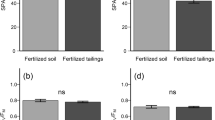Abstract
Hybrid willows (Salix matsudana Koidz × Salix alba L.), weeping willows (Salix babylonica L.) and hankow willows (Salix matsudana Koidz) were exposed to potassium ferrocyanide to determine the potential of these plants to extract, transport and metabolize this iron cyanide complex. Young rooted cuttings were grown in hydroponic solution at 24.0 ± 0.5°C for 144 h. Ferrocyanide in solution, air, and aerial tissues of plants was analyzed spectrophotometrically. Uptake of ferrocyanide from the aqueous solution by plants was evident for all treatments and varied with plant species, ranging from 8.64 to 15.67% of initial mass. The uptake processes observed from hydroponic solution showed exponential disappearance kinetics. Very little amounts of the applied ferrocyanide were detected in all parts of plant materials, confirming passage of ferrocyanide through the plants. No ferrocyanide in air was found due to plant transpiration. Mass balance analysis showed that a large fraction of the reduction of initial mass in hydroponic solution was metabolized during transport within the plant materials. The difference in the metabolic rate of ferrocyanide between the three plant species was comparably small, indicating transport of ferrocyanide from hydroponic solution to plant materials and further transport within plant materials was a limiting step for assimilating this iron cyanide complex. In conclusion, phytoremediation of ferrocyanide by the plants tested in this study has potential field application.



Similar content being viewed by others
References
Barclay M, Hart A, Knowles CJ, Meeussen JCL, Tett VA (1998a) Biodegradation of metal cyanides by mixed and pure cultures of fungi. Enzyme Microb Technol 22:223–231
Barclay M, Tett V, Knowles CJ (1998b) Metabolism and enzymology of cyanide/metallocyanide biodegradation by Fusarium solani under neutral and acidic conditions. Enzyme Microb Technol 23:321–330
Beavis AD, Vercesi AE (1992) Anion uniport in plant mitochondria is mediated by a Mg2+-insensitive inner membrane anion channel. J Biol Chem 267:3079–3087
Dursun AY, Calik A, Aksu Z (1999) Degradation of ferrous (II) cyanide complex ions by Pseudomonas fluorescens. Process Biochem 34:901–908
Ebbs S, Bushey J, Poston S, Kosma D, Samiotakis M, Dzombak D (2003) Transport and metabolism of free cyanide and iron cyanide complexes by willow. Plant Cell Environ 26:1467–1478
Federico R, Giartosio CE (1983) A transplasmamembrane electron transport system in maize. Plant Physiol 73:182–184
Ghosh RS, Dzombak RA, Luthy RG (1999) Equilibrium precipitation and dissolution of iron cyanide solids in water. Environ Eng Sci 16:293–313
Hendrickson HR, Conn EE (1969) Cyanide metabolism in higher plants. IV. Purification and properties of the β-cyanoalanine synthase of blue lupine. J Biol Chem 244:2632–2640
Kjeldsen P (1999) Behaviour of cyanides in soil and groundwater: a review. Wat Air Soil Poll 115:279–307
Kuhn AT (1974) Electrolytic decomposition of cyanides, phenols and thiocyanates in effluent streams – a review. J Appl Chem Biotech 21:29–34
Larsen M, Trapp S, Pirandello A (2004) Removal of cyanide by woody plants. Chemosphere 54:325–333
Larsen M, Trapp S (2006) Uptake of iron cyanide complexes into willow trees. Environ Sci Technol 40: 1956–1961
Manning K (1988) Detoxification of cyanide by plants and hormone action. In: Ciba Foundation (eds) Cyanide compounds in biology. John Wiley & Sons, Chichester, pp 92–110
Maruyama A, Saito K, Ishizawam K (2001) β-cyanoalanine synthase and cysteine synthase from potato: molecular cloning, biochemical characterization, and spatial and hormonal regulation. Plant Mol Biol 46:749–760
Meeussen JL, Keizer MG, Van-Riemsdijk WH (1992) Dissolution behavior of iron cyanide (Prussian blue) in contaminated soils. Environ Sci Technol 26:1832–1838
Miller JM, Conn EE (1980) Metabolism of hydrogen cyanide by higher plants. Plant Physiol 65:1199–1202
Mudder T, Botz M (2001) A guide to cyanide. Mining Environ Manag 9:8–12
Samiotakis M, Ebbs SD (2004) Possible evidence for transport of an iron cyanide complex by plants. Environ Poll 127:169–173
State Environmental Protection Administration of China 1989. Analysis method for water and wastewater (3rd ed). Environmental Science Press, China, Beijing, pp 145–154 (In Chinese)
Theis TL, West MJ (1986) Effects of cyanide complexation on adsorption of trace metals at the surface of goethite. Environ Technol Lett 7:309–316
Trapp S, Zambrano KC, Kusk KO, Karlson U (2000) A phytotoxicity test using transpiration of willows. Arch Environ Contam Toxicol 39:154–160
Trapp S, Christiansen H (2003) Phytoremediation of cyanide-polluted soils. In: McCutcheon SC, Schnoor JL (Eds) Phytoremediation: Transformation and control of contaminants. John Wiley & Sons, Hoboken, pp 829–862
Yu X. Z, Trapp S, Zhou PH, Wang C, Zhou XS (2004) Metabolism of cyanide by Chinese vegetation. Chemosphere 56:121–126
Yu XZ, Trapp S, Zhou PH, Hu H (2005a) The effect of temperature on the rate of cyanide metabolism of two woody plants. Chemosphere 59:1099–1104
Yu XZ, Trapp S, Zhou PH (2005b) Phytotoxicity of cyanide to weeping willows. Environ Sci Poll Res 12:109–113
Yu XZ, Zhou PH, Liu YD, Hu H (2005c) Detoxification of cyanide by woody plants. Arch Environ Contam Toxicol 49:150–154
Yu XZ, Peng XY, Zhou PH (2006) The potential of woody plants for phytoremediation of cyanide. J Hunan Agric Univ (Nat Sci) 32:81–85 (In Chinese)
Acknowledgements
This work was supported by a research foundation from the Hunan Agricultural University for scientists (grant no: 03YJ05). Thanks to Liang Chen and Yawen Tang for their engaged help.
Author information
Authors and Affiliations
Corresponding author
Rights and permissions
About this article
Cite this article
Yu, XZ., Zhou, PH. & Yang, YM. The potential for phytoremediation of iron cyanide complex by willows. Ecotoxicology 15, 461–467 (2006). https://doi.org/10.1007/s10646-006-0081-5
Accepted:
Published:
Issue Date:
DOI: https://doi.org/10.1007/s10646-006-0081-5




